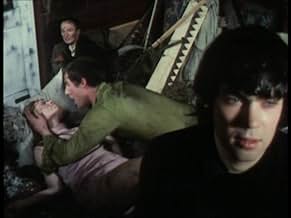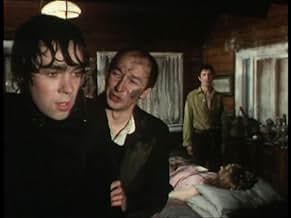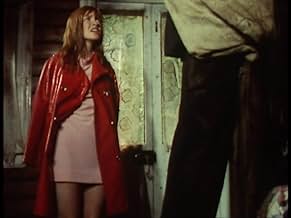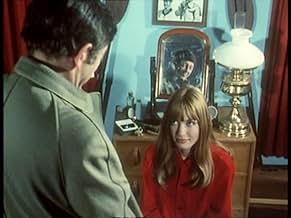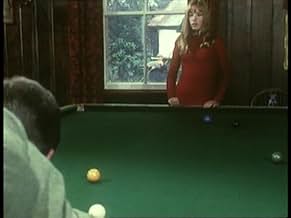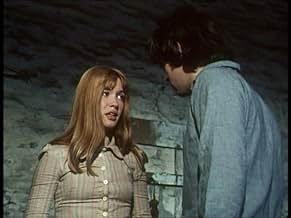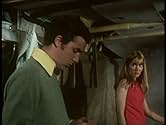Three teenagers discover a mysterious set of owl and flower-patterned dinner plates in the attic and the magical ancient legend of the "Mabinogion" comes to life once again in their Welsh va... Read allThree teenagers discover a mysterious set of owl and flower-patterned dinner plates in the attic and the magical ancient legend of the "Mabinogion" comes to life once again in their Welsh valley.Three teenagers discover a mysterious set of owl and flower-patterned dinner plates in the attic and the magical ancient legend of the "Mabinogion" comes to life once again in their Welsh valley.
Browse episodes
Featured reviews
Supposedly produced for young people, this mini-series has moments of eroticism and sexuality that are too adult for adolescents. The eternally youthful looking Gillian Hills was 24 in 1968 when she starred in this. Gillian, Michael Holden and Francis Wallis form the odd love triangle in an old Welsh country house and are drawn by occult forces to reenact a Welsh myth. They're supposed to be around 15 or 16. There's a weird vibe to the show. There's a modern car and SLR camera in some scenes and the three dress in style contemporary to 1968, especially Gillian who wears the miniskirts of that time. She's petulant and pouty and not really lovingly photographed by the DP and the two guys who vie for her attention are even more pouty and petulant. Yet the rooms in the fetid, worn out house are lit by old-fashioned oil or kerosene lamps making it seem like a house of the 19th century. The audio is in rough condition and with odd dialogue and overwrought acting, the listening is rough going. The Owl Service is not horror, not a soap opera, not a mystery and not a romantic saga but it's a mix of all of them.
This is not actually a movie but a TV series adapted from an award winning novel. Although Garner's work was marketed as children's fiction at his best he is multi-layered and this is one of his best. Alison is on holiday with her newly re-married mother, stepfather and stepbrother at a house in a remote Welsh valley. She begins a relationship with Gwyn, the son of the housekeeper, much to the disgust of her mother but soon parental disapproval is the least of their worries when Gwyn finds an owl-patterned dinner service - the Owl Service of the title - hidden away in the loft and releases an ancient magic into the valley. The past is re-enacted in the present, the tragedy of what has happened over and over in the valley is relived with a modern slant. A brief description like this can't do justice to the creeping tension of the story where even the tiniest, seemingly innocuous, event resonates with unfolding significance. I have the series on video,taped on its last TV outing in 1985 so now twenty years old, and it's not going to last for ever.
Since I wrote this post originally in 2005, and after some lobbying of Granada and Network DVD, the series has now been released. If you've never seen it before buy it, you won't be disappointed. If you have seen it before no doubt you will have already bought it as I have.
Since I wrote this post originally in 2005, and after some lobbying of Granada and Network DVD, the series has now been released. If you've never seen it before buy it, you won't be disappointed. If you have seen it before no doubt you will have already bought it as I have.
It's sad and disappointing that some reviews fail utterly to appreciate that this serial was an absolute classic of its time. It was bold in its conception, using real locations instead of studio-based sets which was unusual for its time. Its many years now since I first saw it but I remember it vividly as a very disturbing piece of story-telling thanks to the wonderful writing of the great Alan Garner and the brilliant direction of Peter Plummer.
I think I'm one of maybe two Americans who have seen this (the other being Steve Puchalski of "Shock Cinema" magazine on whose recommendation I recently bought this DVD, sight unseen, from Amazon UK). This short-lived but fondly remembered British TV series is a very offbeat, supernatural mystery set in the Welsh countryside revolving around a set of dinner plates (that's right--dinner plates) that a step-brother and sister and their housekeeper's son find in the attic of a country cottage. It's a low-budget and (especially by today's standards) low-key affair, but it is nevertheless effective and interesting, at times even unsettling.
You could compare it to the offbeat, unsettling American TV series "Twin Peaks",I guess, but it really has indelible elements of 60's era BBC programming and high-quality children's literature (it was based on a children's book). I personally enjoy all of these things, and being one quarter Welsh, I find Welsh mythology very interesting (although I have to say the Welsh countryside is actually one of the most boring places I've ever visited).
Due to it's roots in children's literature and television, this is obviously not chock-full of sex or violence. But what the mild violence it contains is eerily unsettling, and there is kind of a teen love triangle that is rather perverse in that two of it's members are step-brother and step-sister. Moreover, the step-sister is played by Gillian Hills, a gorgeous 60's-era, Swinging London dolly-bird who is most famous for a pair of three-way sex scenes in two classic movies of that era (with David Hemmings and Jane Birkin in "Blow Up" and with Malcolm McDowell and some other actress in "A Clockwork Orange"). She almost can't help, but bring SOME sex appeal to the proceedings. Still, by modern-day standards this is very tame and rather slow. But I liked it simply because it was offbeat and interesting, and not really like ANYTHING I'd ever seen before.
You could compare it to the offbeat, unsettling American TV series "Twin Peaks",I guess, but it really has indelible elements of 60's era BBC programming and high-quality children's literature (it was based on a children's book). I personally enjoy all of these things, and being one quarter Welsh, I find Welsh mythology very interesting (although I have to say the Welsh countryside is actually one of the most boring places I've ever visited).
Due to it's roots in children's literature and television, this is obviously not chock-full of sex or violence. But what the mild violence it contains is eerily unsettling, and there is kind of a teen love triangle that is rather perverse in that two of it's members are step-brother and step-sister. Moreover, the step-sister is played by Gillian Hills, a gorgeous 60's-era, Swinging London dolly-bird who is most famous for a pair of three-way sex scenes in two classic movies of that era (with David Hemmings and Jane Birkin in "Blow Up" and with Malcolm McDowell and some other actress in "A Clockwork Orange"). She almost can't help, but bring SOME sex appeal to the proceedings. Still, by modern-day standards this is very tame and rather slow. But I liked it simply because it was offbeat and interesting, and not really like ANYTHING I'd ever seen before.
An 8-part TV series that includes a supernatural theme based on folklore, murder, (hinted, off-screen) sex, and demonic possession.
So perfect Sunday teatime viewing for all the family in 1970, with the first episodes being shown just before Christmas 1969.
No need to go into the story too much. It is retelling/updating/"inspired by" story based on a tale from the Mabinogion by acclaimed children's author Alan Garner, who was heavily involved in this TV version of his novel (and as a result it is a very faithful version). It features three young people (probably meant to be aged around 15-16) in an emotional triangle (to call it a love triangle would be misleading), living in a Welsh manor house in a valley cut off from the outside world (no electricity, phone, etc. - which was entirely plausible for the late 60s/early 70s).
The discovery of a strange dinner service results takes over the young girl - Alison - (played very well by an actress some 10 years older than the part she is playing) who is compelled to trace the pattern on the plates and make paper owls. And so the story begins.
After this it gets quite complex - to the extent that the summary of the previous episode that starts episodes 2-8 is absolutely required viewing, even if you are binging the entire series (its available on YouTube) because you will have missed something!
The three young actors (though they are significantly older than the parts they play) do a great job holding together a tale that basically only has six parts in it (the others being the father of two of the children, a live-in housekeeper and mother of the third, and a strange and apparently a little mad handyman/gardener.
Spread over 8 25-minute episodes the story will seem a little slow to modern viewers, with not a great deal of action (you can literally count the number of spots of blood that are shown), but what is hinted at and what probably happens off camera is another matter entirely.
Perhaps this is where the family viewing comes in because adult viewers will likely get the hints that children will miss, such as - to take one fairly mild example - why is Alison "ill" and in bed at the start, in her red nightdress, despite actually appearing quite perky? Not that hard for an adult to guess.
Each episode pushes the story forward with the last one being quite strong stuff, with what is essentially a form of demonic possession centre screen. A suspect a few viewers choked on the Sunday tea when this was shown.
But it is not just the story that would raise eyebrows - and actually make this unfilmable today (for children anyway) - it is also the style of filming. There may be little blood, but the camera loves Alison's legs in their 1960s short skirts to an extent that would be very worrying if you did not know that the actress was 25.
Overall this is a dark, complex, difficult but brilliant drama that uses folklore and the supernatural in a way that would be utterly impossible for the target audience today.
So perfect Sunday teatime viewing for all the family in 1970, with the first episodes being shown just before Christmas 1969.
No need to go into the story too much. It is retelling/updating/"inspired by" story based on a tale from the Mabinogion by acclaimed children's author Alan Garner, who was heavily involved in this TV version of his novel (and as a result it is a very faithful version). It features three young people (probably meant to be aged around 15-16) in an emotional triangle (to call it a love triangle would be misleading), living in a Welsh manor house in a valley cut off from the outside world (no electricity, phone, etc. - which was entirely plausible for the late 60s/early 70s).
The discovery of a strange dinner service results takes over the young girl - Alison - (played very well by an actress some 10 years older than the part she is playing) who is compelled to trace the pattern on the plates and make paper owls. And so the story begins.
After this it gets quite complex - to the extent that the summary of the previous episode that starts episodes 2-8 is absolutely required viewing, even if you are binging the entire series (its available on YouTube) because you will have missed something!
The three young actors (though they are significantly older than the parts they play) do a great job holding together a tale that basically only has six parts in it (the others being the father of two of the children, a live-in housekeeper and mother of the third, and a strange and apparently a little mad handyman/gardener.
Spread over 8 25-minute episodes the story will seem a little slow to modern viewers, with not a great deal of action (you can literally count the number of spots of blood that are shown), but what is hinted at and what probably happens off camera is another matter entirely.
Perhaps this is where the family viewing comes in because adult viewers will likely get the hints that children will miss, such as - to take one fairly mild example - why is Alison "ill" and in bed at the start, in her red nightdress, despite actually appearing quite perky? Not that hard for an adult to guess.
Each episode pushes the story forward with the last one being quite strong stuff, with what is essentially a form of demonic possession centre screen. A suspect a few viewers choked on the Sunday tea when this was shown.
But it is not just the story that would raise eyebrows - and actually make this unfilmable today (for children anyway) - it is also the style of filming. There may be little blood, but the camera loves Alison's legs in their 1960s short skirts to an extent that would be very worrying if you did not know that the actress was 25.
Overall this is a dark, complex, difficult but brilliant drama that uses folklore and the supernatural in a way that would be utterly impossible for the target audience today.
Did you know
- TriviaAs the first fully scripted colour production by Granada Television, the series takes full advantage of the color red, not only in the form of Gillian Hills's stunning red hair, but her wardrobe is almost entirely made up of red miniskirts, bikinis, hats and raincoats.
- ConnectionsFeatured in The Worlds of Fantasy: The Child Within (2008)
- SoundtracksTon Alarch
Performed by Jean Bell
[closing music for each episode]
- How many seasons does The Owl Service have?Powered by Alexa
Details
Contribute to this page
Suggest an edit or add missing content


